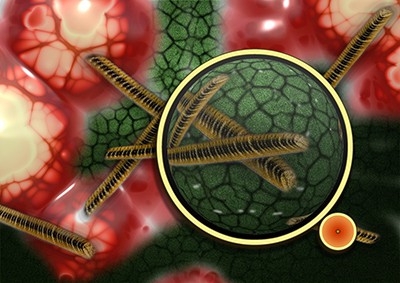Germs
They are everywhere
| Download this episode | Germs. They are everywhere, in the air, on food, plants and animals. You can find germs in soil and water and on just about every other surface, including your body. Most germs won’t harm you because your immune system protects you against infectious agents. However, some germs are difficult enemies because they are constantly mutating to breach our immune system’s defenses. Knowing how germs work can increase your chances of avoiding infection. Germs are microorganisms, which means that they can be seen only through a microscope. The COVID-19 pandemic has raised awareness about the threat that germs hold and brought attention to the need to practice good hygiene at all times. That includes washing your hands well and often, covering your mouth and nose with a tissue when you cough or sneeze, staying home if you are sick and avoiding close contact with people who are sick. | Bacteria are tiny, single-celled germs that get nutrients from their environments. They’re so small that if you lined up a thousand of them end to end, they could fit across the end of a pencil eraser. Some bacteria are good for our bodies, keeping the digestive system in working order and keeping harmful bacteria from moving in. For instance, Lactobacillus acidophilus — a harmless bacterium that resides in your intestines — helps you digest food, destroys some disease-causing organisms and provides nutrients. Some bacteria are used to make medicines and vaccines. But bacteria can cause trouble too, as with cavities, urinary tract infections, ear infections, or strep throat. Many disease-causing bacteria produce toxins, powerful chemicals that damage cells and make you ill. Other bacteria can directly invade and damage tissues. Antibiotics are used to treat bacterial infections. They either kill bacteria or keep them from reproducing. | Viruses are small, even smaller than bacteria. They aren’t even a full cell. In fact, viruses are basically just capsules that contain genetic material. They need to use another cell’s structures to reproduce, which means they can’t survive unless they’re living inside something else, such as a person, animal, or plant. Viruses can only live for a very short time outside of other living cells. For example, viruses in infected body fluids left on surfaces like a countertop or toilet seat can live there for a short time, but quickly die unless a live host comes along. Once they’ve moved into someone’s body, though, viruses spread easily and can make a person sick. Viruses are responsible for some minor sicknesses like the common cold, illnesses like the flu, and very serious diseases like smallpox, shingles or AIDS. Unlike bacteria, antibiotics are not effective against viruses. Antiviral medicines have been developed against a small, select group of viruses. | Fungi are multicelled, plant-like germs. A fungus gets nutrition from plants, food, and animals in damp, warm environments. Mushrooms are fungi, as are the molds that form the blue or green veins in some types of cheese. And yeast, another type of fungus, is a necessary ingredient in most types of bread. Only about half of all types of fungi are harmful. Many fungal infections, such as athlete’s foot and yeast infections, are not dangerous in a healthy person. But people who have weakened immune systems from diseases like HIV or cancer may develop more serious fungal infections. Some fungi reproduce through tiny spores in the air. You can inhale the spores or they can land on you. As a result, fungal infections often start in the lungs or on the skin. Fungi can be difficult to kill. For skin and nail infections, you can apply medicine directly to the infected area. Oral antifungal medicines are also available for serious infections. | The word protozoa comes from the Greek words “protos,” or first, and “zoia,” or animal. Protozoans are single-celled germs that behave like animals, hunting and gathering other microbes for food. Many protozoans live in your intestinal tract and are harmless. Others cause diseases, like malaria and toxoplasmosis. Protozoans often spend part of their life cycles outside of humans or other hosts, living in food, soil, water or insects. Some protozoans invade your body through the food you eat or the water you drink. Others, such as malaria, are spread by mosquitoes. Protozoan infections can be cured through medications that kill the single-celled parasites that cause the condition. Before treatment is started, your doctor will do various tests to identify the protozoa and choose the appropriate antiprotozoal. A protozoan infection should be treated as soon as possible. If the condition is allowed to persist, permanent damage to the major organs can occur.
Transcript
Bacteria
Transcript
Viruses
Transcript
Fungi
Transcript
Protozoa
Transcript
